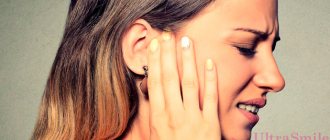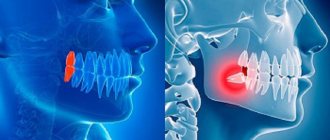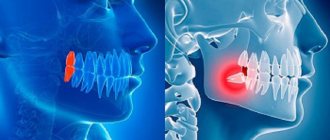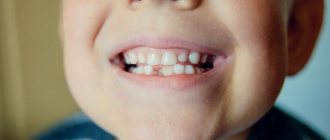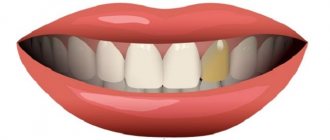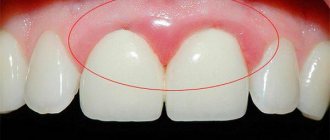Toothache in medical practice is otherwise called dentalgia. It is a specific reaction to various provoking factors (traumatic injuries, diseases of the teeth and gums, jaw defects and abnormalities in its structure). The most common cause of toothache in patients of all ages is caries. In some cases, the pathological reaction is based on factors not related to oral health. If your teeth hurt only on one side, you may need the help of not only a dentist, but also highly specialized specialists (for example, a neurologist, cardiologist, and even an otolaryngologist).
Characteristic features of unilateral dentalgia
A sharp toothache, for example, on the left side can act as a symptom of a heart attack. If it is aching in nature, there is a high probability of trigeminal neuralgia. In these situations, self-medication is strictly prohibited due to the risk of complications. Therefore, at the first symptoms of dentalgia, you should consult a doctor.
Unilateral toothache usually occurs suddenly. It has a widespread course, when all dental units of both jaws are affected. It is also highly intense.
The pathological process can be provoked by inflammatory tissue pathologies, diseases of the vascular, nervous or cardiac systems. In most cases, patients note the appearance of acute, sometimes throbbing pain. Much less often they go to the doctor with dull pain.
Almost always, discomfort negatively affects people’s quality of life and their psycho-emotional state. They cannot eat or sleep normally, which leads to problems with the digestive tract and central nervous system.
A sleep disorder is diagnosed in almost 90% of patients with widespread dentalgia, since the pain syndrome intensifies at night. During rest, the functional activity of the adrenal cortex decreases. In addition, the natural synthesis of so-called steroid hormones, which have analgesic properties, is reduced.
If the cause of dentalgia is dental disorders, the discomfort intensifies after direct contact with cold or eating excessively spicy or hot foods. It is enough just to open your mouth in frosty or windy weather for the pain syndrome to sharply intensify.
Psychosomatic dentalgia is often a consequence of stressful situations and strong psycho-emotional experiences. To eliminate discomfort, it is often enough to eliminate the provoking factor. Some patients benefit from sessions with a psychotherapist or taking mild sedatives.
Dental factors provoking unilateral dentalgia
Regardless of the degree and specific localization of dentalgia, diseases of the oral cavity are its most common cause. Discomfortable sensations may be the result of the carious process. If several adjacent dental units are affected simultaneously, dentalgia will be perceived by the patient as pain spreading throughout the entire jaw and always on one side. However, he will not be able to say exactly where it hurts.
Complicated types of caries
With a complicated version of caries, a pathological cavity does not simply form. It usually contains necrotic tissue, food debris, and bacterial plaque. The so-called peripulpal dentin is also damaged - this is the bone tissue that surrounds the pulp of the dental unit.
If a dentist diagnoses a patient with a superficial or medium caries process, the pathology can quickly transform into a complicated form. Moreover, in almost all cases it spreads to adjacent teeth.
Caries is considered a slow-growing but progressive dental disease. In the absence of timely and high-quality treatment, it can lead to complications. As a rule, no more than 3 years pass from the formation of the so-called chalk stain to severe tissue damage.
Acute pulpitis
Acute pulpitis is considered one of the most painful ailments of dental etiology. It is characterized by the spread of pain. Therefore, if primary symptoms occur, you should consult a doctor to exclude involvement of the pulp and directly periapical tissues in the pathological process.
Pulp is commonly understood as connective tissue, which is localized in the dental canals. It has a loose structure and a large number of blood vessels. Due to the many nerve endings, its defeat is always accompanied by severe discomfort. The pulp provides nutrition to the tooth from the inside.
When the pulp is inflamed, the following symptoms may appear:
- periodic pain syndrome, which increases sharply at night;
- increased sensitivity of enamel;
- after removal of the provoking factor, discomfort persists.
In the case of pulpitis, the pain is usually localized throughout the jaw and intensifies each time after direct contact with food. With the purulent nature of the disease, discomfort increases only when heat is applied to the affected area. The use of cold helps reduce its intensity.
Ignoring the symptoms of pulpitis can lead to the development of complications and complete loss of a dental unit. Treatment is carried out exclusively by surgery. The dentist performs a complete resection of the neurovascular bundles and pulp tissue.
Apical periodontitis
This disease is manifested by inflammation of periodontal tissue. They are localized between the root of the tooth and the immediate alveolar plate.
Periodontitis is characterized by inflammation of the periodontal tissues located between the tooth root and the alveolar plate and holding the tooth in the bony alveolus.
Not only the carious process can provoke a pathological process. Often, the disease is caused by injuries and minor injuries, as well as improper use of medications. Sometimes pain occurs after treatment when the materials or drugs used (for example, arsenic) penetrate the periodontium.
A characteristic symptom of the apical variant of periodontitis is local pain. It appears exclusively in the affected area. As it progresses, the discomfort becomes widespread. The pain can radiate to neighboring teeth, as well as to the temple, ear, or jaw.
The clinical picture of pulpitis and periodontitis is almost identical. However, an important difference between the latter is the appearance of severe pain during tapping of the tooth.
Necrotizing ulcerative gingivitis
Gingivitis is another common oral disease. It is characterized by inflammation of the gum tissue.
Gingivitis on its own rarely provokes pain. Unpleasant sensations are concentrated in the gum tissue. We are talking about itching and severe burning, tingling, and increased dryness of the mucous membranes. The course of certain types of gingivitis can provoke a pain syndrome that spreads to several dental units, but only on one side.
The table below details their main features:
| Type of gingivitis | Short description |
| Scaly | Gingival epithelial cells are intensively exfoliated. Severe pain and hyperemia of soft tissues are observed in the affected area. |
| Ulcerative | The gums bleed heavily and become bright red. Possible appearance of purulent ulcers. In 80% of cases, patients note not only discomfort in the affected area, but also severe burning and itching. |
| Hyperplastic | The first distinguishing sign of hyperplastic gingivitis is the external change of the gums. They acquire a purple and sometimes bluish tint. The tissues bleed heavily, and purulent secretion is possible. Another characteristic feature of this variant of the disease is the formation of false gum pockets. It is almost always accompanied by an increase in the size of the periodontal papillae. In particularly serious cases, hyperplasia spreads to the dental crowns. |
| Necrotizing | This type of disease got its name due to the formation of necrotic areas on the papillae, which are located between the dental units. |
Other dental causes
Among other common causes of toothache, doctors name:
- traumatic damage to molars and gum tissue;
- inflammation in periodontal tissues;
- tooth abscess, cystic formations;
- perimaxillary phlegmon;
- eruption of so-called wisdom teeth;
- cracks in dental units.
Poorly treated caries can cause severe discomfort. We are talking about those cases when, after visiting the dentist, pieces of necrotic tissue remain in the tooth. They can act as a cause of re-infection.
Neurological causes
This category includes causes associated with central nervous system dysfunction. Diseases of this kind are usually diagnosed in patients of the older age category. However, in the presence of a number of unfavorable factors, they can also appear in people 30-40 years old. The cause of the disorder is usually eliminated after taking sedatives or tranquilizers. However, these types of drugs are not recommended for use on a regular basis. Their help should be sought in exceptional cases.
Trigeminal neuralgia
This medical term usually refers to damage to the trigeminal nerve. This is a paired cerebral nerve, which is responsible for sensitivity in the cheek and lips, ensures the functioning of the organs of vision and smell. The main causes of trigeminal neuralgia are mechanical compression, when its processes are compressed by growths or spasmed muscles, and irritation.
Also, the pathological process can progress after recent acute respiratory viral infections, acute respiratory infections or influenza. As a result, after another severe hypothermia, the corresponding symptoms appear.
The pain syndrome in this pathology is localized on one side of the face, but has a wide area of irradiation. Discomfort can manifest itself in the area of the teeth, neck, eye sockets, sides of the nose and temples. Its severity is always high, which affects a person’s quality of life. He cannot eat or sleep properly, move or work. The duration of each pain syndrome varies between 1.5-3 minutes.
Not only degenerative and dystrophic changes in the cervical spine are among the main causes of neuralgia. The pathology also develops against the background of ENT disease, increased nervous excitability and frequent hypothermia. Nerve damage is possible due to compression by a neoplasm, including a malignant one, or changes in the blood vessels.
Cluster syndrome
Cluster headache is a cyclical disorder. In this case, the person experiences severe headaches. They are localized mainly on one side of the face, but can spread to the cheeks, nose, forehead, teeth and jaws. The discomfort is so strong that there are known cases of suicide attempts when people could not cope with it.
The attack always appears suddenly and can last from 10 minutes to 2 hours. Their number per day can vary from 2 to 10. The attack has the following clinical features:
- cutting pain in the eyes, as if they were being pierced with a sharp object;
- lacrimation;
- nasal congestion, mucous secretion;
- swelling of the eyelids;
- increase in heart rate;
- decreased quality of vision;
- subconjunctival hemorrhage.
With cluster syndrome, the duration of toothache is the same as the headache. Upon completion of the next attack, dentalgia goes away on its own. No special correction is required.
After alternating attacks of cluster headaches, a period of calm begins. At this time the person feels well. This period can last from 6 months to 3-4 years.
Content:
- Why it hurts to press on a tooth - the main reasons 1.1. Increased sensitivity 1.2. Traumatic injuries (history or recent) 1.3. Periodontitis 1.4. Inflammation of the gums 1.5. Poor quality dental prosthesis 1.6. Cyst 1.7. Caries 1.8. Pulpitis
- If pain occurs when pressing on a filled tooth
- What you can do yourself
When pain occurs in a tooth affected by caries, or at the base of which there is swollen and inflamed gum, everything is clear - you urgently need to go to the dentist and undergo treatment. But what to do if a person’s tooth hurts when biting and no visual defects are noticeable.
Is it possible to ignore this situation? Dentists are convinced that no. If acute or aching pain occurs when pressing on a tooth, you must definitely find out its cause. Otherwise, the risk of crown failure or root damage will increase in the future.
Pathologies of ENT organs
Unilateral dentalgia may be a consequence of diseases of the ENT organs, which is due to the structural features of the oropharynx, nasopharynx, and ears. We are talking, first of all, about adenoiditis, otitis media and sinusitis. The help of an otolaryngologist to exclude and differentially diagnose ENT diseases will be required in cases where unilateral dentalgia is combined:
- nasal congestion, when the patient loses the ability to breathe fully;
- headaches;
- the occurrence of discharge from the ears (a clear symptom of purulent otitis media);
- high temperature;
- pain in the ears;
- sore throat;
- copious purulent discharge from the nose.
When the inflammatory process in the paranasal sinuses or middle ear acts as a provoking factor for unilateral dentalgia, the pain goes away on its own after it stops. Broad-spectrum antibiotics (macrolides, cephalosporins, penicillin medications) are used for treatment. Additionally, anti-inflammatory and antibronchoconstrictor drugs (Fenspiride), as well as drugs to stimulate the motor function of the respiratory tract (Sinupret) are prescribed.
Causes of aching pain on both sides of the jaw
Pain in only one part of the jaw is not very dangerous. If all the teeth above or below ache, then you should be concerned. The reasons why such pain occurs can be very dangerous:
- inflammation of the trigeminal nerve;
- sinusitis and sinusitis;
- heart problems.
Inflammation of the trigeminal nerve or paranasal sinuses occurs due to colds and infectious diseases. Typically, pathologies are accompanied by a general deterioration of immunity.
With inflammation of the ternary nerve, aching pain in the teeth and jaw is felt more strongly in the upper part of the face and noticeably intensifies with any movement of the mouth. Sinusitis and sinusitis are types of inflammation in the sinuses. They are covered with a sensitive mucous membrane, in which the inflammatory process occurs. Therefore, pain from sinusitis and sinusitis is also concentrated in the upper part of the jaw.
The cause of aching pain in the teeth can be heart problems. If it radiates to the shoulders and arms, the patient probably suffered a myocardial infarction some time ago.
Toothache as a sign of a heart attack
A heart attack is a cardiovascular pathology. It is also one of the clinical forms of ischemic disease. The mortality rate for heart attack is more than 60%.
Intact toothache on the left side of the jaw is considered one of the precursors of vascular pathology. It occurs 12-24 hours before an attack. Along with dentalgia, patients complain of headache, shortness of breath, nonproductive cough and changes in the normal heart rhythm.
The main symptom of a heart attack is considered to be angular pain. It appears 10-20 hours after the first manifestations. The duration of the attack itself varies from several minutes to an hour. To stop it, you need to take a Nitroglycerin tablet.
Health care
The occurrence of dentalgia is a signal to seek medical help. If toothache appears above and below, you should not self-medicate. You need to make an appointment with the dentist. If the pain syndrome does not allow you to sleep and do your usual activities, it is better to contact the emergency clinic.
At home and only as an emergency measure, non-narcotic analgesics and non-steroidal anti-inflammatory drugs are allowed. The most popular drugs from these groups, their approximate dosage are presented in the table below.
| Drug name | Single dosage | Maximum daily dosage |
| Analgin | 500 mg | 3000 mg of active substance |
| Citramon | 1 tablet | 3 tablets |
| Ketorol | 10 mg of active ingredient | 40 mg of active ingredient |
| Paracetamol | 500 mg | 4000 mg of active ingredient |
| Mefenamic acid | 500 mg of active substance | no more than 2000 mg of active substance |
| Diclofenac | 25 mg of active substance | no more than 150 mg of active substance |
| Ibuprofen | up to 800 mg | 2400 mg of active substance |
The dosages presented in the table are advisory in nature and selected for adult patients. For children, these indicators are calculated individually and only according to the instructions included with the drug.
What can you do if all your teeth hurt at once?
It is important to understand that you cannot endure severe pain, especially in all teeth at once. If you experience discomfort, you should visit the nearest dental clinic as soon as possible and undergo an examination. Under no circumstances should you take strong painkillers for a long period of time, especially without a doctor’s prescription.
If you neglect your health, the consequences can be irreversible and very serious. Experts do not recommend applying hot compresses to the sore spot, as increased blood circulation can lead to even more unpleasant sensations.
To alleviate your condition a little before going to the clinic, you can rinse your mouth with a soda solution. It is also allowed to take 1-2 tablets of the most common painkiller, for example, analgin. Before purchasing, you should definitely consult with the seller; most likely, he will be able to suggest the most suitable drug.
previous post
What to do if a tooth is overgrown with gum?
next entry
Preventive actions
It is easier to prevent any disease than to subsequently engage in long-term and energy-consuming treatment. This rule also applies to dentalgia. To prevent toothache, experts give the following recommendations:
- Teeth should be brushed twice a day. For this procedure, it is important to choose the right brush and paste. After each meal and whenever possible, you should rinse your mouth. Both ordinary water and special solutions are suitable for these purposes.
- We must not forget about the existence of such assistants as irrigators, dental brushes and floss. These devices allow you to reach hard-to-reach places. As a result, bacteria and plaque will not accumulate, which prevents the risk of caries.
- You need to visit the dentist every six months. This approach allows you to notice the problem at an early stage of development and immediately eliminate it. This helps to prevent complications of the pathological process later.
- You should give up bad habits. Tobacco smoke is considered the most dangerous. It can change the composition of saliva, which only further contributes to the accumulation of plaque.
- It is better to minimize the amount of overly sweet and soft foods in your diet. The thing is that sugar is a favorable environment for the life of pathogenic flora. Soft foods do not allow teeth to naturally cleanse themselves of plaque.
Dentalgia is a very common and at the same time unpleasant phenomenon. It can unbalance any person and significantly worsen the quality of his life. Dentalgia prevents you from eating and sleeping properly, working, and doing household chores. If your teeth hurt on one side, you should not self-medicate. It is necessary to seek help from a dentist as soon as possible. After identifying the cause of the pain, he will prescribe appropriate treatment or refer you for consultation to specialized specialists.
Sore gums: how to treat?
Competent and effective treatment of gums can only be carried out by a periodontist. Depending on the diagnosis and stage of the disease, he can prescribe a number of therapeutic measures to the patient.
- Professional hygiene . This is a mandatory procedure performed by a hygienist. In one procedure, it removes all dental deposits and bacteria living in them, not only from the surface of the teeth, but also under the gum. In addition, the hygienist will correct your home oral care, show you how to brush your teeth properly, and select a brush and products for you, taking into account your individual problems.
- Treatment with the Vector device. For effective treatment in scientific dentistry "Naudent" they use the Vector device (Germany). It delicately cleans the periodontal pocket to a depth of 11 mm and works gently even in the most difficult to reach places, ensuring maximum cleanliness. Thanks to ultrasound, Vector-therapy destroys the biofilm of microorganisms, and a powerful flow of liquid removes it from under the gums. A special solution washes and disinfects the gums. Thanks to its gentle effect, the system allows you to effectively and at the same time completely painlessly reduce the depth of periodontal pockets. Bleeding, pain and swelling disappear.
- Plasmolifting. The patient's blood plasma is injected into the inflamed areas of the gums by injection. This procedure is absolutely painless and has a beneficial effect on the condition of the gums: bleeding and inflammation disappear, and tooth mobility decreases. It is important that the healing effect is noticeable after the first procedure.
- Physiotherapy. A course of physiotherapy may include electrophoresis, massage, photodynamic therapy and ultrasound treatment. These procedures are prescribed as an addition to the main treatment. They have a complex effect, improve prognosis and reduce treatment time.
- Surgery. In advanced cases, when the inflammation has gone too far and therapeutic methods have not shown the desired result, the periodontist can only carry out surgical treatment. This may be curettage, gingivectomy or gum grafting. Doctors at scientific dentistry "Naudent" use the Fonalaser laser (Germany) for this purpose. It removes diseased gum tissue with virtually no pain or bleeding, and the recovery period is quick. Also, a diode laser is used to correct the gingival margin and remove tumors.
If you can’t go to the doctor right now, and your gums hurt, then you can temporarily reduce the level of inflammation on your own with the help of:
- Dental gels for gum pain relief
- Herbal rinses to relieve inflammation (chamomile, sage, eucalyptus)
Only an integrated approach can effectively solve problems with gum disease and forget about pain for a long time. Remember that it is important to take care not only of dental health, but also to monitor the condition of the entire oral cavity.
